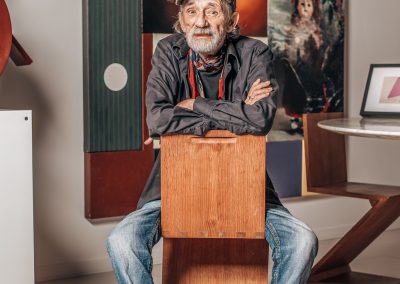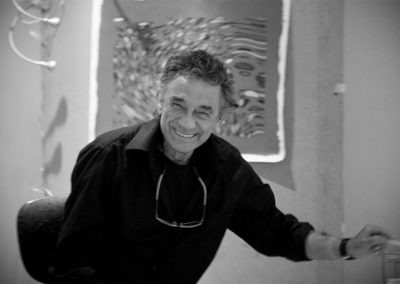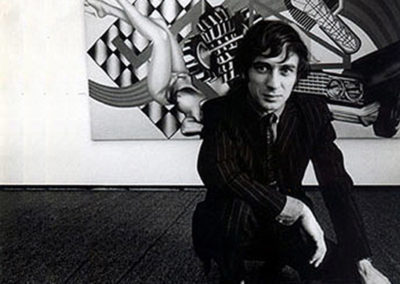About
Peter Phillips, born in Birmingham England in 1939, is one of the preeminent British Pop Artists of our time. His work ranges from oils on canvas to multi-media compositions and collages. Vibrant in color and filled with borrowed iconography of images drawn from daily life, Peter’s work appeals to the spectator’s memory, elevates curiosity and awakens their minds to the world around them.
As one of the originators of Pop Art, Peter got his start at the Royal College of Arts with his fellow students David Hockney, Allen Jones, R.B. Kitaj and others of the British Pop Art Movement. When he was awarded a Harkness Fellowship he moved to New York, where he exhibited his work alongside his American counterparts Andy Warhol, Roy Lichtenstein and James Rosenquist.
Peter’s work has been exhibited in countless museums worldwide, featured in BBC films and documentaries, visited by the Queen, commissioned for the World Cup and listed in countless history books globally. Having created over a thousand pieces of art Peter is considered one of the most prolific artists of his time.
Now residing in Australia, Peter has recently completed a state-of-the-art studio in the Noosa Hinterland where he continues to work and exhibit. VIEW BIOGRAPHY
Peter Phillips, born in Birmingham England in 1939, is one of the preeminent British Pop Artists of our time. His work ranges from oils on canvas to multi-media compositions and collages. Vibrant in color and filled with borrowed iconography of images drawn from daily life, Peter’s work appeals to the spectator’s memory, elevates curiosity and awakens their minds to the world around them.
As one of the originators of Pop Art, Peter got his start at the Royal College of Arts with his fellow students David Hockney, Allen Jones, R.B. Kitaj and others of the British Pop Art Movement. When he was awarded a Harkness Fellowship he moved to New York, where he exhibited his work alongside his American counterparts Andy Warhol, Roy Lichtenstein and James Rosenquist.
Peter’s work has been exhibited in countless museums worldwide, featured in BBC films and documentaries, visited by the Queen, commissioned for the World Cup and listed in countless history books globally. Having created over a thousand pieces of art Peter is considered one of the most prolific artists of his time.
Now residing in Australia, Peter has recently completed a state-of-the-art studio in the Noosa Hinterland where he continues to work and exhibit. VIEW BIOGRAPHY
Peter Phillips, born in Birmingham England in 1939, is one of the preeminent British Pop Artists of our time. His work ranges from oils on canvas to multi-media compositions and collages. Vibrant in color and filled with borrowed iconography of images drawn from daily life, Peter’s work appeals to the spectator’s memory, elevates curiosity and awakens their minds to the world around them.
As one of the originators of Pop Art, Peter got his start at the Royal College of Arts with his fellow students David Hockney, Allen Jones, R.B. Kitaj and others of the British Pop Art Movement. When he was awarded a Harkness Fellowship he moved to New York, where he exhibited his work alongside his American counterparts Andy Warhol, Roy Lichtenstein and James Rosenquist.
Peter’s work has been exhibited in countless museums worldwide, featured in BBC films and documentaries, visited by the Queen, commissioned for the World Cup and listed in countless history books globally. Having created over a thousand pieces of art Peter is considered one of the most prolific artists of his time.
Now residing in Australia, Peter has recently completed a state-of-the-art studio in the Noosa Hinterland where he continues to work and exhibit. VIEW BIOGRAPHY
From Rewind: Five Decades of Peter Phillips (2007)
by Marco Livingstone.
“Aged only 18 when he entered the postgraduate painting course at the Royal College of Art in 1959. Peter Phillips was not only the youngest but one of the most technically gifted of that remarkable class, which included in his number David Hockney, Allen Jones, R.B. Kitaj and Derek Boshier. His Pop paintings of 1961, both the earliest and most ambitious by any British artist, arose naturally from his passions as a teenager and from his intense response to the surface sheen of modern life as experienced through photography, cinema, illustration, graphic design, games and all the desirable products devised by industry and made yet more glamorous through advertising.
By the end of the decade, Phillips was to produce paintings on a billboard scale, deftly manipulating his borrowed imagery with the aid of a tool employed by advertisers and photographic retouchers, the airbrush. The effect of his hands-off surfaces was simultaneously to claim responsibility for his selection of forms and images and to distance himself from the elements he juggled, as if they had floated unbidden into the space of his pictures. Through the many changes in his procedures and favored formats, this trancelike atmosphere remains in force, endowing his art with a mystery and allure a long way from the prosaic and banal sources from which he begins. The rigorous geometry of his pictures and the apparent objectivity and detachment with which he deploys both his processes and the component parts serve as a highly effective means of disguising the ultimately intuitive, subjective, poetic and even romantic nature of his art. the longer one looks at a Phillips, the more powerfully its strangeness takes its hold on the imagination.
Looking back from the early 21st century to the works made by Phillips in each of five decades, I am struck by the consistency of his vision through many changes of imagery, structure and technique. To experience these works in a sequence is akin to rewinding a tape containing samples from an artist’s greatest hits – if I may be allowed the theft of the title of a particularly haunting painting of 2002 – or, perhaps more accurately, to playing at random some favorite songs on one of those great flashing Wurlitzer juke boxes of the artist’s youth.
The endlessly vibrant nature of Phillips’ work is based so firmly in the modern world (as mediated by found images) but also prone to constant flights of fantasy suggestive of dreamlike states. Declaring his freedom to dart in and out of abstraction and to consider every period of his work, every device and compositional strategy, as a legitimate starting point for new pictures, Phillips remains a start of the mythical Sixties, forever young.” VIEW ARTICLES



